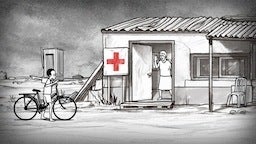February 9, 2012 — A new animated video about cholera—how people get infected, how it spreads, and how to treat it—is drawing attention from health workers around the globe.
The video’s producer, Deborah Van Dyke, is a nurse practitioner in Vermont, a longtime aid worker for Doctors Without Borders, and a 1993 graduate of Harvard School of Public Health.
Van Dyke hopes the video, as well as others she is producing on newborn care, will benefit health care workers in low-resource settings all over the world. “People learn and remember through visual media,” she said. “It’s a great tool.”
Van Dyke’s videos—some animated, some live—are being produced through her fledgling nonprofit, the Global Health Media Project, and will be available for free via Internet download, viewable on smartphones or other mobile devices, and available on DVD or flash drive.
Animating a disease
Produced in collaboration with award-winning animator Yoni Goodman, the four-and-a-half minute video, “The Story of Cholera,” was released in late December and has already been seen by viewers in more than 100 countries. Simple and informative, it features a story about a young boy who helps his cholera-stricken father. Van Dyke wanted to make visible the invisible germs to help people more easily understand how the disease is spread and how to prevent it. So the cholera germs appear yellow against the black-and-white animation.
Health workers in countries such as Haiti, Cameroon, Zambia, Ghana, Kenya, and Thailand have expressed interest in using the video. Van Dyke has plans to translate it into multiple languages.
The animation shows how human waste can infect local water supplies; how people contract cholera by ingesting tainted water or food, through skin-to-skin contact like a handshake that could lead to ingestion of the germ, or from flies; and the severe intestinal distress that cholera causes. It shows how to initiate rehydration of cholera victims with a solution of clean water, salt, and sugar, anywhere at any time. And it shows how to prevent cholera by boiling water supplies, using chlorine drops, washing hands before preparing or eating food, and making sure that human waste doesn’t get into the local water supply.
“Cholera itself is readily treated,” notes Van Dyke. “And understanding that whatever you put into your mouth needs to be totally clean goes a long way in helping you avoid getting sick.”
Video as training tool
After seeing too much needless loss of life on numerous missions abroad—to Sudan, India, Kosovo, China, Tajikistan, and other places—Van Dyke thought videos might be an effective training tool for health workers in low-resource, often isolated settings. She’d been thinking about it since 2005, during a mission in Afghanistan, where she developed training materials for health care providers. One day she showed a short video about inserting an IUD to a group of Afghan doctors, which, Van Dyke said, “electrified the room.” She searched for other such videos, but couldn’t find any that were clear, up-to-date, and tailored to low-resource realities. “It was a real gap,” she said.
Then, in the spring of 2008, leading a medical team in Sudan, Van Dyke saw a newborn resuscitation go wrong. She intervened and the baby lived, but the incident galvanized her. She knew that, too often, such situations turned tragic because health workers lack certain skills—not through any fault of their own, but simply because of minimal access to critical health care information.
In that moment, Van Dyke imagined creating a video focused on the basic technique for resuscitating a newborn.
“I thought to myself, ‘By employing new technology, this brief video could spread to health workers around the world quickly and easily,’ ” she said. “To see a limp blue newborn coming alive through the relatively simple technique of resuscitation is unforgettable. Teaching the technique through video will save newborn lives.” Although she didn’t know anything about producing videos, she decided to give it a try.
Back in the states, she took a week-long video production course to learn the basics of pre-production, filming, lighting, sound, and editing.
In addition to the cholera video, Van Dyke just finished the first 10 of the newborn care videos; they’re currently being field-tested. In each of her videos, Van Dyke solicits content from experts all over the world, and directs professional filmmakers in clinical sites in the developing world. The newborn care videos feature close-up views of health care workers on location in Nigeria and the Dominican Republic, as well as some animation to emphasize key learning points.
These days, Van Dyke divides her time between working as a nurse practitioner and developing the videos—networking to find collaborators, fundraising, and shooting footage worldwide, including Latin America, Africa, and Asia. Eventually, she said, she hopes to produce videos on other topics, such as childbirth complications, infection prevention, HIV, tuberculosis, and malaria.
Said Van Dyke, “We are eager to bring alive this simple and elegant solution of ‘moving images’ to help health workers gain the knowledge and basic skills that we know save lives.”
–Karen Feldscher
